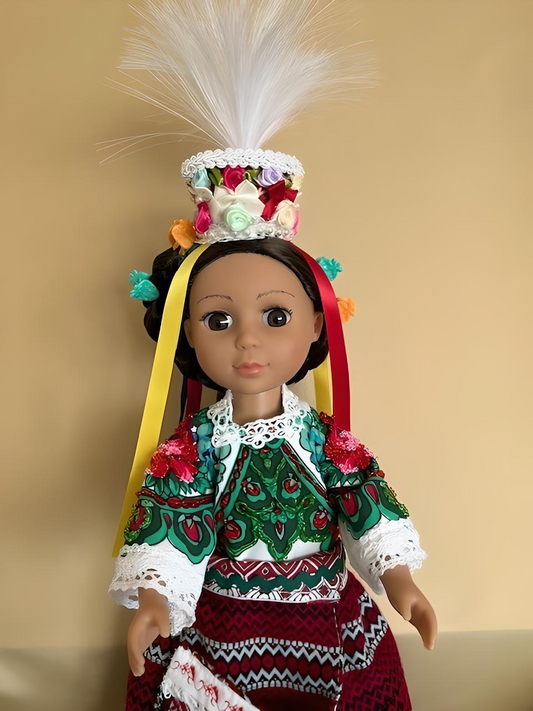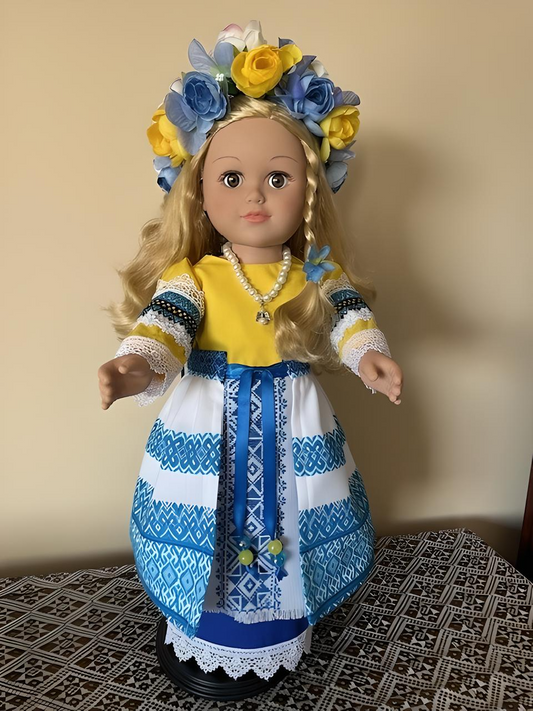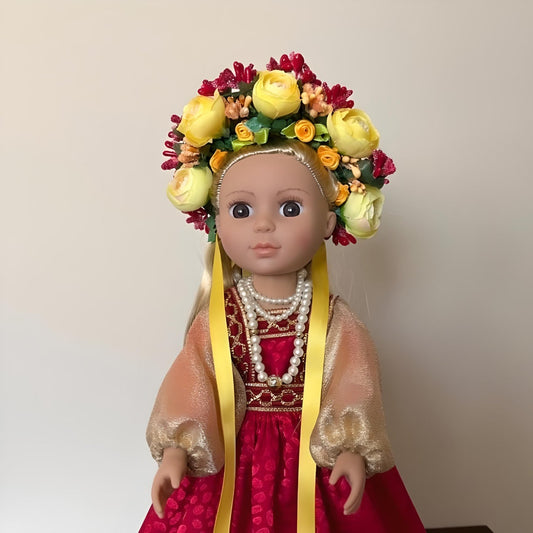Ukrainian Dolls: The Timeless Motanka Doll Tradition
Origins of Ukrainian Dolls and Motanka
Ukrainian dolls, especially the motanka doll, trace their roots to ancient Trypillian culture over 5,000 years ago. Early communities in what is now Ukraine viewed the human figure in rag form as a mediator between mother earth and ancestral spirits. Ancestors believed that each motanka connected the living with nature’s cycles, guided by the lunar calendar. No needles or scissors were used when crafting these emotive figures. Instead, women wrapped cloth and fabric to form a faceless doll. The absence of facial features prevented evil spirits from entering, ensuring the doll maintained a protective function for the house and family.

Motanka Doll as Sacred Talisman
A motanka doll was often made by a village elder or grandmother—usually a woman of high wisdom—on a day chosen for its alignment with the full moon. In that one-day ritual, positive thoughts accompanied each twisting of fabric and binding of cloth. Herbs, such as chamomile or mint, were included to invoke healing water’s medicinal virtues. As a result, these ceremonial doll figures symbolized well being and fertility. Each layer of fabric—sometimes yellow, brown, or blue—depicted elemental ties: straw for earth, wool for warmth, and linen for purity.

Crafting a Motanka Doll: Materials and Rituals
Creating a motanka doll requires simple supplies: strips of cloth, ribbons, sacred herbs, straw, and occasionally coins for prosperity. Farmers contributed materials—flax stems, wool fibers, and mistletoe—for specific healing or protective purposes. Craftspeople avoided fabric from mourning clothes or quarrelsome arguments, believing that discordant energy would spoil the doll’s sanctity. The doll’s core became an embodiment of family and community ties: a mother’s devotion, a village’s shared hopes, and a grandmother’s whispered blessings.

Materials and Symbolic Fabric Choices
The fabric used for a motanka often included blue cloth to invoke the sky’s healing power, green wool for growth, and white linen for spiritual connection. Red ribbons were bound around the waist to symbolize vitality and protection. In some regions, brown flax strips represented fertility of the soil. Each piece of fabric was tied—not sewn—emphasizing the unbroken cycle of life.
Ritual Steps and Timing
In many districts of Ukraine, doll makers followed the lunar calendar, choosing a Friday before a full moon to ensure stronger protective power. A typical ceremony began with a communal prayer to mother earth and the goddess of harvest. Neighbors often brought herbs—yarrow for healing, chamomile for calm—and coins as tokens of goodwill. By sunset, the motanka doll was placed in a sacred corner of the house, its protective function immediate and profound.
Symbolism and Protective Function of Motanka Dolls
Motanka dolls served authentic household guardianship. Families placed them in the pokutya—the sacred corner of a house—so that evil spirits were kept at bay. The cross on the face represented the sun’s life-giving energy and the balance of masculine and feminine forces. In agricultural rites, these humble dolls featured in ceremonies to call rain during spring equinox or to bless the grain at harvest festivals. For example, a guardian motanka might hang from a barn beam while farmers invoked healing water from nearby springs.
Role in Household and Seasonal Rituals
Every home had at least one motanka doll perched on a shelf or mantel. At Kupala Night, young girls floated motanka on river currents to ensure rain. During autumn harvest, families created harvest motanka stuffed with grains and herbs to invite abundance. Ancestors believed that presenting a motanka to newborn children would secure protection from birth onward, wrapping the swaddle motanka in lavender for soothing dreams.
Categories of Motanka Dolls and Their Uses
Dolls in Ukrainian tradition fall into categories: guardian, fertility, healing, traveler, wedding, and swaddle. Each type performed a specific role:
- Berehynya (Guardian) Doll: A protective figure ensuring the household’s well being.
- Pelenashka (Swaddle) Doll: A small motanka placed near infants to guard against evil spirits.
- Vesilna (Wedding) Doll: Crafted for brides, adorned with regional patterns and colorful ribbons to bless unions.
- Podorozhnytsya (Traveler) Doll: Offered safe passage and a happy return for travelers.
- Healing Doll: Filled with herbs like mint and yarrow to absorb illness, later burned in ritual as a cleansing act.
Example: The Vesilna Motanka
On the wedding day, two vesilna dolls—tied together with red ribbon—were presented to the bride. Each doll’s fabric featured green and red embroidery patterns unique to Galychyna or Bukovyna regions. In some customs, the bride carried the dolls from her childhood home to the ceremony, symbolizing transition and unity.
Regional Patterns and Fabric Traditions
Ukrainian dolls reflect regional styles. In Bukovyna, geometric embroidery in blue and green adorned the doll’s garments, while Hutsul traditions included woolen vests and bead necklaces. Galychyna dolls often had floral headscarves in yellow and red. These patterns were not mere decoration but conveyed local identity and folk beliefs.
Cloth, Needlework, and Accessories
Needlework was minimal—stitches were rare—because motanka relied on tied cloth. Accessories, such as beaded necklaces and head wreaths, complemented the doll. Ribbons in blue or brown hung from the head to symbolize water and earth. Each accessory conveyed layers of meaning for the family that owned it.
Modern Revival of Ukrainian Motanka Dolls
Since Ukraine’s independence in 1991, motanka dolls have reemerged as symbols of national identity. Workshops in Canada teach diaspora communities how to craft motanka, blending traditional techniques with local materials. In Toronto, cultural festivals feature live demonstrations, drawing visitors to search for authentic crafts. A notable example: the “100 Motanka for Peace” exhibition in Japan showcased Ukrainian doll making as cultural diplomacy.
Motanka Business and Cultural Tourism
Artisans now sell motanka dolls online, using local fabric blends and offering custom colors to match home décor. Some businesses incorporate doll making into retreats, where visitors can learn to develop fine motor skills while connecting with Ukrainian culture. The site often highlights how these dolls evolve from simple play dolls for children into ceremonial doll icons for adult collectors.
Play Dolls vs. Ceremonial Doll Traditions
Traditional motanka dolls were not made as play dolls; their intended purpose was ceremonial. However, modern artisans sometimes create motanka play dolls with gentle painted faces to appeal to girls and youth. These play dolls help children develop fine motor skills as they practice tying ribbons and fabric. Despite this adaptation, the original motanka’s protective and ritual significance remains respected.
Nesting Dolls, Babushka Dolls, and Matryoshka Explained
While Ukrainian dolls often refer to motanka, many visitors search for nesting dolls or babushka dolls. Nesting dolls—popularly called matryoshka—were inspired by traditional folk dress and emerged in late 19th-century Russia. Babushka dolls derive from the Russian word for grandmother and often depict a mother figure. These dolls differ from motanka: matryoshka contain smaller figures nested inside, whereas motanka are single, faceless figures meant for protection, not play.
Difference Between Matryoshka and Babushka Dolls
Matryoshka dolls feature multiple wooden figures that nest one inside another, often depicting a mother earth or grandmother figure. Babushka dolls are similar but usually represent a single elderly woman. Neither nesting doll type carries the ceremonial functions of a motanka doll, which remains faceless and tied, not painted.
Preserving Motanka Craftsmanship and Culture
Across Ukraine and diaspora sites, motanka doll makers aim to sustain this heritage. Workshops, online tutorials, and cultural business initiatives promote needlework techniques and the use of authentic fabric. By sharing stories—such as the WWII example of families burying dolls with valuables—today’s artisans ensure the motanka’s legacy endures. In doing so, they reinforce community bonds and honor the goddess of protection embodied in every motanka doll.
Future of Motanka Tradition
As culture evolves, so do motanka dolls. From rural households to urban galleries, families treasure these figures for their symbolic power. Whether sold as a gift or crafted at home, motanka dolls stand as living testaments to Ukraine’s spiritual heritage. Visitors to your site can explore doll-making kits, join workshops, or purchase handcrafted motanka dolls—ensuring this timeless tradition thrives for generations to come.
-
Doll "Bukovynka" in a Hand-Embroidered Ukrainian Beads Costume Unique Head Piece from Bukovyna Region
Regular price $180.00 CADRegular priceUnit price / per -
Blue & White Doll "Mariya" in Ukrainian Folk Outfit
Regular price $159.50 CADRegular priceUnit price / per -
Bright Yellow and Blue Ukrainian Costume Doll in Hand-Made Cross-Stitch Outfit "Sophiya"
Regular price $219.90 CADRegular priceUnit price / per -
Handmade Wreath | Removable Clothes | Handmade Decorative Doll | Doll Art | Unique Birthday Gift | Interior Décor
Regular price $180.00 CADRegular priceUnit price / per




